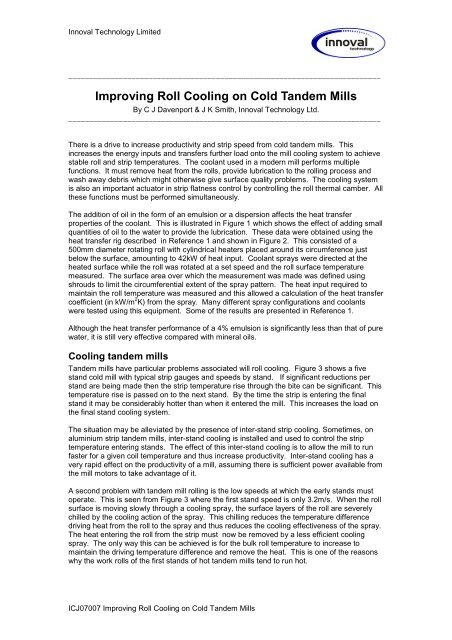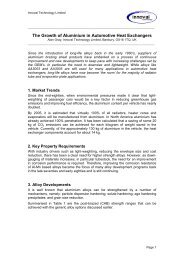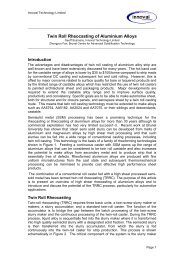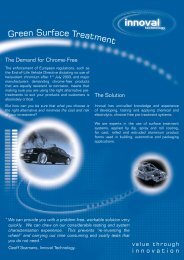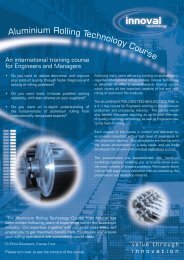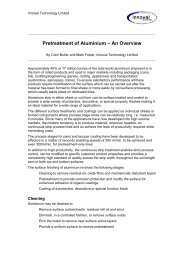Improving Roll Cooling on Cold Tandem Mills - Innoval Technology ...
Improving Roll Cooling on Cold Tandem Mills - Innoval Technology ...
Improving Roll Cooling on Cold Tandem Mills - Innoval Technology ...
You also want an ePaper? Increase the reach of your titles
YUMPU automatically turns print PDFs into web optimized ePapers that Google loves.
<strong>Innoval</strong> <strong>Technology</strong> Limited<br />
__________________________________________________________________________<br />
<str<strong>on</strong>g>Improving</str<strong>on</strong>g> <str<strong>on</strong>g>Roll</str<strong>on</strong>g> <str<strong>on</strong>g>Cooling</str<strong>on</strong>g> <strong>on</strong> <strong>Cold</strong> <strong>Tandem</strong> <strong>Mills</strong><br />
By C J Davenport & J K Smith, <strong>Innoval</strong> <strong>Technology</strong> Ltd.<br />
__________________________________________________________________________<br />
There is a drive to increase productivity and strip speed from cold tandem mills. This<br />
increases the energy inputs and transfers further load <strong>on</strong>to the mill cooling system to achieve<br />
stable roll and strip temperatures. The coolant used in a modern mill performs multiple<br />
functi<strong>on</strong>s. It must remove heat from the rolls, provide lubricati<strong>on</strong> to the rolling process and<br />
wash away debris which might otherwise give surface quality problems. The cooling system<br />
is also an important actuator in strip flatness c<strong>on</strong>trol by c<strong>on</strong>trolling the roll thermal camber. All<br />
these functi<strong>on</strong>s must be performed simultaneously.<br />
The additi<strong>on</strong> of oil in the form of an emulsi<strong>on</strong> or a dispersi<strong>on</strong> affects the heat transfer<br />
properties of the coolant. This is illustrated in Figure 1 which shows the effect of adding small<br />
quantities of oil to the water to provide the lubricati<strong>on</strong>. These data were obtained using the<br />
heat transfer rig described in Reference 1 and shown in Figure 2. This c<strong>on</strong>sisted of a<br />
500mm diameter rotating roll with cylindrical heaters placed around its circumference just<br />
below the surface, amounting to 42kW of heat input. Coolant sprays were directed at the<br />
heated surface while the roll was rotated at a set speed and the roll surface temperature<br />
measured. The surface area over which the measurement was made was defined using<br />
shrouds to limit the circumferential extent of the spray pattern. The heat input required to<br />
maintain the roll temperature was measured and this allowed a calculati<strong>on</strong> of the heat transfer<br />
coefficient (in kW/m 2 K) from the spray. Many different spray c<strong>on</strong>figurati<strong>on</strong>s and coolants<br />
were tested using this equipment. Some of the results are presented in Reference 1.<br />
Although the heat transfer performance of a 4% emulsi<strong>on</strong> is significantly less than that of pure<br />
water, it is still very effective compared with mineral oils.<br />
<str<strong>on</strong>g>Cooling</str<strong>on</strong>g> tandem mills<br />
<strong>Tandem</strong> mills have particular problems associated will roll cooling. Figure 3 shows a five<br />
stand cold mill with typical strip gauges and speeds by stand. If significant reducti<strong>on</strong>s per<br />
stand are being made then the strip temperature rise through the bite can be significant. This<br />
temperature rise is passed <strong>on</strong> to the next stand. By the time the strip is entering the final<br />
stand it may be c<strong>on</strong>siderably hotter than when it entered the mill. This increases the load <strong>on</strong><br />
the final stand cooling system.<br />
The situati<strong>on</strong> may be alleviated by the presence of inter-stand strip cooling. Sometimes, <strong>on</strong><br />
aluminium strip tandem mills, inter-stand cooling is installed and used to c<strong>on</strong>trol the strip<br />
temperature entering stands. The effect of this inter-stand cooling is to allow the mill to run<br />
faster for a given coil temperature and thus increase productivity. Inter-stand cooling has a<br />
very rapid effect <strong>on</strong> the productivity of a mill, assuming there is sufficient power available from<br />
the mill motors to take advantage of it.<br />
A sec<strong>on</strong>d problem with tandem mill rolling is the low speeds at which the early stands must<br />
operate. This is seen from Figure 3 where the first stand speed is <strong>on</strong>ly 3.2m/s. When the roll<br />
surface is moving slowly through a cooling spray, the surface layers of the roll are severely<br />
chilled by the cooling acti<strong>on</strong> of the spray. This chilling reduces the temperature difference<br />
driving heat from the roll to the spray and thus reduces the cooling effectiveness of the spray.<br />
The heat entering the roll from the strip must now be removed by a less efficient cooling<br />
spray. The <strong>on</strong>ly way this can be achieved is for the bulk roll temperature to increase to<br />
maintain the driving temperature difference and remove the heat. This is <strong>on</strong>e of the reas<strong>on</strong>s<br />
why the work rolls of the first stands of hot tandem mills tend to run hot.<br />
ICJ07007 <str<strong>on</strong>g>Improving</str<strong>on</strong>g> <str<strong>on</strong>g>Roll</str<strong>on</strong>g> <str<strong>on</strong>g>Cooling</str<strong>on</strong>g> <strong>on</strong> <strong>Cold</strong> <strong>Tandem</strong> <strong>Mills</strong>
<strong>Innoval</strong> <strong>Technology</strong> Limited<br />
It should be noted that although the outer surface of the rolls is chilled by the sprays, this<br />
chilling is c<strong>on</strong>fined to <strong>on</strong>ly a few millimetres of depth below the surface. A few millimetres<br />
below the roll surface the temperature is almost c<strong>on</strong>stant around the circumference.<br />
One of the c<strong>on</strong>sequences of the sharp temperature gradients in the radial directi<strong>on</strong> within the<br />
roll is the impositi<strong>on</strong> of thermal stresses. These stresses are repeated and reversed every<br />
rotati<strong>on</strong> of the roll and so c<strong>on</strong>tribute to fatigue damage of the roll surface.<br />
<str<strong>on</strong>g>Roll</str<strong>on</strong>g> cooling illustrati<strong>on</strong><br />
Figure 4 shows the spray pattern produced <strong>on</strong> a roll from three banks of flat jet sprays with<br />
the sprays twisted at 15° to the horiz<strong>on</strong>tal. The r oll surface has been opened out into a flat<br />
surface so that the bottom of the diagram shows the roll bite and the top is where the work<br />
roll meets the back-up roll. The diagram shows the effective extent of each of the spray<br />
banks acting <strong>on</strong> the roll surface and also gives the <str<strong>on</strong>g>Cooling</str<strong>on</strong>g> Effect of the bank. This is the<br />
number written at the right hand side of the pattern. The <str<strong>on</strong>g>Cooling</str<strong>on</strong>g> Effect is the heat transfer<br />
coefficient generated by the spray pattern <strong>on</strong> the roll surface multiplied by the circumferential<br />
extent of the bank Its units are kW/K m width. It depends <strong>on</strong> both the shape of the spray<br />
pattern and the flow rate of coolant supplied to the nozzles. These values are calculated by<br />
<strong>Innoval</strong> software which incorporates a large volume of published data and analysis <strong>on</strong><br />
cooling sprays to allow the heat transfer calculati<strong>on</strong>s to be made. Not shown in Figure 4, but<br />
included in the heat transfer calculati<strong>on</strong>s, is a layer of coolant active <strong>on</strong> the roll surface below<br />
the Bank 1 spray. This layer provides further cooling of the roll.<br />
The diagram in Figure 4 also shows the sensitivity of the spray pattern shape to the roll<br />
diameter. The sensitivity is greater for the off-centre sprays than for those pointing directly at<br />
the roll. Note also that the level of lateral overlap of the spray patterns is sensitive to roll<br />
diameter and to the positi<strong>on</strong> of the spray pattern around the roll circumference. This is more<br />
obvious when the sprays are pointing at a small glancing angle to the roll.<br />
In order to illustrate the effect of surface chilling <strong>on</strong> the cooling effectiveness, the following<br />
case is c<strong>on</strong>sidered:<br />
Units<br />
Minimum, nominal and maximum roll<br />
510, 530 and mm<br />
diameters<br />
550<br />
Net heat input to the roll from the strip 200 kW/m width<br />
Coolant flow rate 1.15 l/min m width<br />
If all the flow is used in a single bank of sprays, the rolls run at a higher temperature than if<br />
the same flow is distributed between three banks. This is seen in Figure 5 which shows the<br />
roll temperature as a functi<strong>on</strong> of roll speed for <strong>on</strong>e, two and three banks respectively with the<br />
same total coolant flow in all cases. The calculati<strong>on</strong>s made here include the effect of the<br />
coolant layer below the Bank 1 sprays.<br />
This illustrates that it is far more effective to distribute the flow <strong>on</strong> the roll surface than to<br />
c<strong>on</strong>centrate it at a high intensity <strong>on</strong> a very small circumferential porti<strong>on</strong> of the roll. This is<br />
particularly important for slowly rotating stands. In this situati<strong>on</strong>, little will be achieved by<br />
increasing the pressure or the nozzle size of a spray c<strong>on</strong>centrated over a small area <strong>on</strong> a<br />
slowly rotating roll. The roll speed effect disappears at higher speeds. However, even at high<br />
speeds there is still a superiority of three banks over a single bank due to the better use of the<br />
roll surface area to remove heat.<br />
Sometimes it is not possible to install three spray banks <strong>on</strong> the mill due to space restricti<strong>on</strong>s.<br />
There are ways of making a single or double bank cool over a larger area by varying the<br />
major and twist angles for a flat jet and the major angle for a c<strong>on</strong>e spray. These possibilities<br />
can all be explored using the appropriate computati<strong>on</strong>s of spray pattern as shown in Figure 4.<br />
If two spray patterns lie close together <strong>on</strong> the roll surface then it will not be possible to obtain<br />
the sum of the benefits of the banks acting separately. This is because of spray pattern<br />
ICJ07007 <str<strong>on</strong>g>Improving</str<strong>on</strong>g> <str<strong>on</strong>g>Roll</str<strong>on</strong>g> <str<strong>on</strong>g>Cooling</str<strong>on</strong>g> <strong>on</strong> <strong>Cold</strong> <strong>Tandem</strong> <strong>Mills</strong>
<strong>Innoval</strong> <strong>Technology</strong> Limited<br />
interacti<strong>on</strong>. The sprays from each bank interfere as they attempt to operate <strong>on</strong> the same area<br />
of the roll surface. This is a very comm<strong>on</strong> scenario and <strong>on</strong>e which must be included in the<br />
calculati<strong>on</strong> of the total effect of groups of banks.<br />
Flatness c<strong>on</strong>trol<br />
The cooling sprays provide a powerful actuator for strip flatness c<strong>on</strong>trol by allowing the rapid<br />
adjustment of the local thermal state of the roll by switching spray banks <strong>on</strong> and off. Very<br />
small changes in local thermal expansi<strong>on</strong> of the roll will produce measurable flatness changes,<br />
so that <strong>on</strong>ly the very outermost parts of the roll need to be affected by the spray switching.<br />
This means that the changes can be made very rapidly because <strong>on</strong>ly a very small mass of the<br />
roll is being affected by the spray changes. These changes are normally reviewed by the<br />
flatness system every few sec<strong>on</strong>ds.<br />
Reference 2 shows a method of quantifying the effects of switching off a spray nozzle <strong>on</strong> the<br />
cooling in the z<strong>on</strong>es to the left and right of it. Algorithms are proposed which can be used in<br />
computer models for calculating the distributi<strong>on</strong> of heat transfer coefficient <strong>on</strong> a roll surface<br />
resulting from particular switching patterns.<br />
In flatness c<strong>on</strong>trol it is important to be able to distinguish the effect of switching individual<br />
lateral z<strong>on</strong>es of sprays. If the sprays overlap excessively, then the c<strong>on</strong>trol will be “soft”. The<br />
roll diameter variati<strong>on</strong>s affect the degree of overlap and the sensitivity of the overlap to roll<br />
diameter depends <strong>on</strong> the nozzle/roll distance and the other nozzle parameters. The banks<br />
need to designed carefully to make the pattern overlap insensitive to roll diameter.<br />
It is also important that the spray patterns do not have excessive lateral asymmetry, since in<br />
this case, switching off a bank will affect the z<strong>on</strong>e to the left differently from that to the right.<br />
This will have an undesirable effect <strong>on</strong> the rolled flatness. In designing a roll cooling system it<br />
is important to take into account all these factors. When they are included in the proper way,<br />
the effect <strong>on</strong> the performance of the roll cooling system can be quite striking.<br />
References<br />
1. Method of Measuring Heat Transfer between a Rotating <str<strong>on</strong>g>Roll</str<strong>on</strong>g> and a <str<strong>on</strong>g>Cooling</str<strong>on</strong>g> Spray<br />
C J Davenport<br />
Ir<strong>on</strong>making and Steelmaking Vol. 23 No. 1 . 1996<br />
2. Measurement and Modelling of <str<strong>on</strong>g>Roll</str<strong>on</strong>g> <str<strong>on</strong>g>Cooling</str<strong>on</strong>g> Distributi<strong>on</strong>s<br />
C J Davenport<br />
Proc. Institute of Metals. Modelling of Metal <str<strong>on</strong>g>Roll</str<strong>on</strong>g>ing Processes. Symposium 3.<br />
Predicti<strong>on</strong> and C<strong>on</strong>trol of Thermal C<strong>on</strong>diti<strong>on</strong>s. 12 th December 1991. L<strong>on</strong>d<strong>on</strong>.<br />
Figure capti<strong>on</strong>s<br />
Figure 1. Influence of oil additi<strong>on</strong>s <strong>on</strong> the effectiveness of roll coolants.<br />
Figure 2. Test rig for measurement the heat transfer performance of cooling sprays<br />
(Reference 1).<br />
Figure 3 Schematic of a five stand tandem mill showing stand speeds and strip gauges.<br />
Figure 4 Spray patterns <strong>on</strong> the roll surface from three banks <strong>on</strong> the entry side of a mill stand.<br />
The figures to the right of each pattern are the calculated <str<strong>on</strong>g>Cooling</str<strong>on</strong>g> Effects of each bank (kW/K<br />
m width)<br />
Fig 5 Effect of roll speed and spray distributi<strong>on</strong> (<strong>on</strong>e, two or three banks) <strong>on</strong> work roll<br />
temperature. The total coolant flow is the same in all three cases.<br />
ICJ07007 <str<strong>on</strong>g>Improving</str<strong>on</strong>g> <str<strong>on</strong>g>Roll</str<strong>on</strong>g> <str<strong>on</strong>g>Cooling</str<strong>on</strong>g> <strong>on</strong> <strong>Cold</strong> <strong>Tandem</strong> <strong>Mills</strong>
<strong>Innoval</strong> <strong>Technology</strong> Limited<br />
Heat transfer coefficient<br />
Pure water<br />
Water+1% oil<br />
Water+4% oil<br />
Coolant flow<br />
Figure 1 Influence of oil additi<strong>on</strong>s <strong>on</strong> the effectiveness of roll coolants.<br />
Figure 2 Test rig for measurement the heat transfer performance of cooling sprays<br />
(Reference 1).<br />
ICJ07007 <str<strong>on</strong>g>Improving</str<strong>on</strong>g> <str<strong>on</strong>g>Roll</str<strong>on</strong>g> <str<strong>on</strong>g>Cooling</str<strong>on</strong>g> <strong>on</strong> <strong>Cold</strong> <strong>Tandem</strong> <strong>Mills</strong>
<strong>Innoval</strong> <strong>Technology</strong> Limited<br />
Figure 3 Schematic of a five stand tandem mill showing stand speeds and strip gauges.<br />
Figure 4 Spray patterns <strong>on</strong> the roll surface from three banks <strong>on</strong> the entry side of a mill stand.<br />
The figures to the right of each pattern are the calculated <str<strong>on</strong>g>Cooling</str<strong>on</strong>g> Effects of each bank (kW/K<br />
m width)<br />
ICJ07007 <str<strong>on</strong>g>Improving</str<strong>on</strong>g> <str<strong>on</strong>g>Roll</str<strong>on</strong>g> <str<strong>on</strong>g>Cooling</str<strong>on</strong>g> <strong>on</strong> <strong>Cold</strong> <strong>Tandem</strong> <strong>Mills</strong>
<strong>Innoval</strong> <strong>Technology</strong> Limited<br />
90.0<br />
85.0<br />
Bulk <str<strong>on</strong>g>Roll</str<strong>on</strong>g> Temperature, C<br />
80.0<br />
75.0<br />
70.0<br />
65.0<br />
Stand 1<br />
1 bank<br />
2 banks<br />
3 banks<br />
60.0<br />
0 5 10 15 20 25<br />
<str<strong>on</strong>g>Roll</str<strong>on</strong>g> circumferential speed, m/s<br />
Figure 5 Effect of roll speed and spray distributi<strong>on</strong> (<strong>on</strong>e, two or three banks) <strong>on</strong> work roll<br />
temperature. The total coolant flow is the same in all three cases.<br />
ICJ07007 <str<strong>on</strong>g>Improving</str<strong>on</strong>g> <str<strong>on</strong>g>Roll</str<strong>on</strong>g> <str<strong>on</strong>g>Cooling</str<strong>on</strong>g> <strong>on</strong> <strong>Cold</strong> <strong>Tandem</strong> <strong>Mills</strong>


